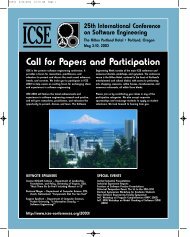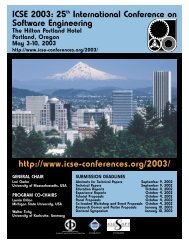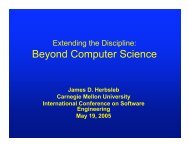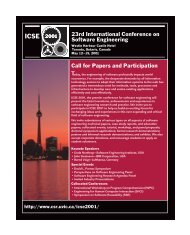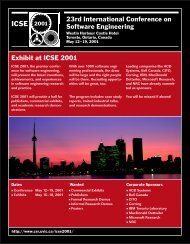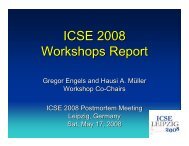ICSE 2001 Conference Proceedings Format
ICSE 2001 Conference Proceedings Format
ICSE 2001 Conference Proceedings Format
Create successful ePaper yourself
Turn your PDF publications into a flip-book with our unique Google optimized e-Paper software.
2<br />
references — that is, a numbered list at the end of the article,<br />
ordered alphabetically by first author, and referenced by<br />
numbers in brackets (e.g., “[1]”). See the examples of<br />
citations at the end of this document. Within this template<br />
file, use the style named Numbered for the text of your<br />
citation; the first citation should be of paragraph tag<br />
Numbered1.<br />
References should be published materials accessible to the<br />
public. Internal technical reports may be cited only if they<br />
are easily accessible (i.e., you can give the address to obtain<br />
it within your citation) and may be obtained by any reader.<br />
Proprietary information should not be cited. Private<br />
communications should be acknowledged, not referenced<br />
(e.g., “[Robertson, personal communication]”).<br />
Page Numbering, Headers and Footers<br />
Page numbers should be included in your submission for<br />
review. There are headers built into this template for page<br />
numbers. Do not add other headers or footers. Final<br />
submission of accepted papers should not include any page<br />
numbers; they will be added for you when the publications<br />
are assembled. (Just delete the header frames from the<br />
master page to remove them.)<br />
4 SECTIONS<br />
The title of a section should be in Times Roman 10-point<br />
bold in all capitals (paragraph tag: Heading1). Please<br />
number the sections. Do not number the abstract,<br />
acknowledgements, or references sections. (Use Heading0<br />
for those unnumbered headers.)<br />
Subsections<br />
The title of subsections should be in Times Roman 10-point<br />
bold with only the initial letters of each word capitalized<br />
(paragraph tag: Heading2). For subsections and<br />
subsubsections, a word like the and a is not capitalized<br />
unless it is the first word of the heading.<br />
Subsubsections<br />
The heading for subsubsections should be in Times Roman<br />
10-point italic with initial letters of each word capitalized<br />
(paragraph tag: Heading3).<br />
5 FIGURES<br />
Figures should be inserted at the appropriate point in your<br />
text. Figures may extend over the two columns up to 17.8 cm<br />
(7”) if necessary. Black and white photographs (not Polaroid<br />
prints) may be mounted on the camera-ready paper with glue<br />
or double-sided tape. (To avoid smudges, attach figures by<br />
paste or tape applied to their back surfaces only.)<br />
6 LANGUAGE, STYLE AND CONTENT<br />
The written and spoken language of <strong>ICSE</strong> <strong>2001</strong> is English.<br />
Spelling and punctuation may consistently use any dialect of<br />
English (e.g., British, Canadian or US). Please write for an<br />
international audience:<br />
• Write in a straightforward style. Try to avoid long sentences<br />
and complex sentence structure. Use semicolons<br />
carefully.<br />
• Use common and basic vocabulary (e.g., use the word<br />
“unusual” rather than the word “arcane”).<br />
• Briefly define or explain all technical terms.<br />
• Explain all acronyms when they first appear in your text<br />
such as, “World Wide Web (WWW)”<br />
• Explain “insider” comments. Be sure that your whole<br />
audience will understand any reference whose meaning<br />
you do not explain (e.g., do not assume that everyone has<br />
used a Macintosh or MS-DOS).<br />
• Use unambiguous forms for representing culturally localized<br />
concepts, such as times, dates, and currencies, (e.g.,<br />
“1-5-98” or “5/1/98” may mean 5 January or 1 May, and<br />
“seven o’clock” may mean 7:00 am or 1900).<br />
Authors are responsible for ensuring that their work is<br />
conducted in a professional and ethical manner [1],<br />
including (but not limited to) fully informed consent of<br />
participants in studies, protection of personal data (e.g., [3]),<br />
and permission to use others’ copyrighted materials.<br />
7 INFORMATION AND QUESTIONS<br />
For more information, contact icse<strong>2001</strong>@csr.uvic.ca.<br />
ACKNOWLEDGEMENTS<br />
This document has been adapted from past <strong>ICSE</strong> <strong>Conference</strong><br />
<strong>Proceedings</strong> <strong>Format</strong> specifications. The <strong>ICSE</strong> 97 format was<br />
in turn adapted from the Style Sheet defined for CHI 96 by<br />
Michael J. Muller, Bonnie Nardi, and Michael J. Tauber, and<br />
numerous people in the CHI community. Judith Meskill<br />
translated that document into a FrameMaker template file.<br />
Their contributions are gratefully acknowledged.<br />
REFERENCES<br />
1. Anderson, R.E. Social impacts of computing: Codes of<br />
professional ethics. Social Science Computing Review<br />
10, 2 (Winter 1992), 453-469.<br />
2. <strong>ICSE</strong> <strong>2001</strong> Web Site, On-line at .<br />
3. Mackay, W.E. Ethics, lies and videotape. . . in Proc.<br />
CHI’95 (Denver CO, May 1995), ACM Press, 138-145.



